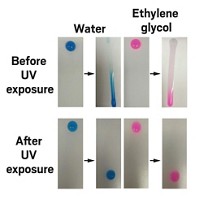Advertisement
Grab your lab coat. Let's get started
Welcome!
Welcome!
Create an account below to get 6 C&EN articles per month, receive newsletters and more - all free.
It seems this is your first time logging in online. Please enter the following information to continue.
As an ACS member you automatically get access to this site. All we need is few more details to create your reading experience.
Not you? Sign in with a different account.
Not you? Sign in with a different account.
ERROR 1
ERROR 1
ERROR 2
ERROR 2
ERROR 2
ERROR 2
ERROR 2
Password and Confirm password must match.
If you have an ACS member number, please enter it here so we can link this account to your membership. (optional)
ERROR 2
ACS values your privacy. By submitting your information, you are gaining access to C&EN and subscribing to our weekly newsletter. We use the information you provide to make your reading experience better, and we will never sell your data to third party members.
Surface Chemistry
Greasy Sponge Slurps Up Oil
Materials Science: A chemical treatment makes a household sponge thirsty for oil instead of water
by Erika Gebel
June 26, 2013

A sponge that can’t absorb a single drop of water may seem like a dud. But if it readily soaks up oil, it could help purify chemical syntheses or clean up oil spills on water. Researchers now report a simple chemical method for turning a household sponge into a water-blocking oil absorber (Ind. Eng. Chem. Res. 2013, DOI: 10.1021/ie400942t).

In response to oil spills on water, cleanup crews often turn to sorbent materials, such as wool, straw, cotton, and synthetic sponges, to separate oil from the water. Sponges are the best choice for the job, say Zhaozhu Zhang and colleagues at the Chinese Academy of Science. The materials can absorb a lot of liquid in a short time, and they can float. However, they suck up water as well as oil, so the sponges’ soaking capacity isn’t fully used to remove oil. To make the materials more efficient, Zhang and colleagues decided to make an oil-specific sponge.
The researchers purchased polyurethane sponges at a local furniture store and coated its entire surface with a thin layer of polypyrrole. This polymer is well known for being water-repellent and having a strong affinity for oil, says Paul L. Edmiston, a chemist at the College of Wooster, who was not involved in this study.
To prepare the sponge for its polypyrrole coating, the researchers first dipped it into ferric chloride and 1H, 1H, 2H, 2H-perfluorooctyltriethoxysilane (PTES). They then put the PTES-coated sponge into a sealed chamber over a pool of volatile pyrrole, which vaporized and infused the sponge. The PTES helped the pyrrole adhere to the sponge surface. Meanwhile, the iron from the ferric chloride helped to catalyze the polymerization of the pyrrole into a thin coating over the sponge’s pores.
When the scientists added droplets of water to the surface of the revamped sponge, the water stayed in a bead and wasn’t absorbed. Droplets of oil, however, disappeared into the sponge immediately. The researchers also dipped the sponge into a variety of oils, including motor oil and soybean oil. The sponge sopped up more than 20 times its dry weight for each of the oils. The team tested how the sponge fared after reuse: They sopped up oil with the sponge and then wrung out the absorbed oil. After repeating those steps five times, the sponge could absorb at least 17 times its weight in oil.
Other groups have modified meshlike materials to absorb oil, Edmiston says. But he likes the idea of an oil-absorbing sponge, because it has “lots of room to pick up the oil.”
Edmiston is concerned that the cost of making these sponges would be prohibitive in the case of a large-scale oil-spill cleanup operation. Although the sponges themselves are cheap, the chemicals used in the treatment are expensive. The superhydrophobic sponges, though may find a place in certain industrial operations, Edmiston says, like removing hydrophobic solvents during chemical syntheses. Such small-scale applications would probably be the first uses for the revamped sponges, he says.




Join the conversation
Contact the reporter
Submit a Letter to the Editor for publication
Engage with us on Twitter